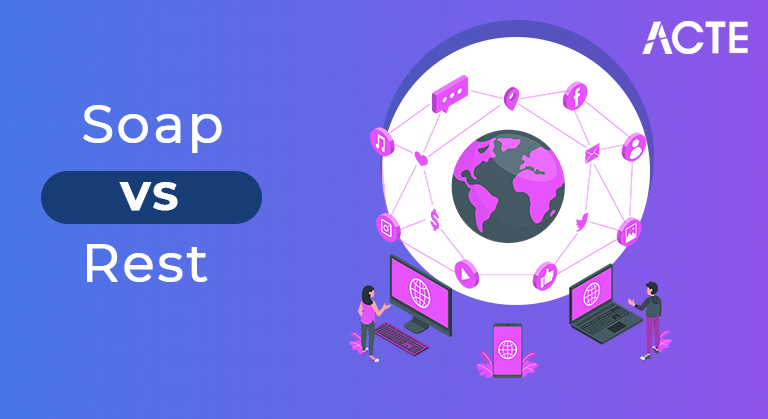
SOAP stands for Simple Object Access Protocol whereas REST stands for Representational State Transfer. SOAP needs more bandwidth for its usage whereas REST doesn’t need much bandwidth. Comparing SOAP vs REST API, SOAP only works with XML formats whereas REST work with plain text, XML, HTML and JSON.
- What is SOAP?
- What is SOAP?
- What is REST?
- Key Differences: for SOAP and REST
- When should REST be used?
- When should SOAP be used?
- Advantage of SOAP and Rest
- Features of SOAP and Rest
- Conclusion
What is SOAP?
SOAP is a protocol that was designed before REST and came into the picture. The main idea behind designing SOAP was to ensure that programs built on different platforms and programming languages can exchange data in an easy way. SOAP stands for Simple Object Access Protocol.
SOAP: Simple Object Access ProtocolSOAP is a standard protocol that was first designed so that applications built in different languages and on different platforms can communicate. Because it is a protocol, it implements built-in rules that increase its complexity and overhead, which can lead to longer page load times. However, these standards also provide built-in compliance that can make it better suited for enterprise scenarios. Underlying compliance standards include security, atomicity, consistency, isolation and durability (ACID), a set of properties to ensure reliable database transactions.
Common web service specifications include:
Web Service Security (WS-Security): Standardised how messages are secured and transferred via unique identifiers called tokens.
WS-ReliableMessaging: Standardised error handling between messages transferred across untrusted IT infrastructure.
Web services addressing (WS-addressing): Instead of maintaining such information deep within the network, SOAP packages the information as metadata within headers.
Web Service Description Language (WSDL): Describes what a web service does, and where that service starts and ends.
When a request for data is sent to the SOAP API, it can be handled via any of the application layer protocols: HTTP (for web browsers), SMTP (for email), TCP, and others. However, once the request is received, the return SOAP messages must be returned as XML documents—a markup language that is both human- and machine-readable. A completed request to a SOAP API is not cacheable by the browser, so it cannot be accessed later without sending it to the API.
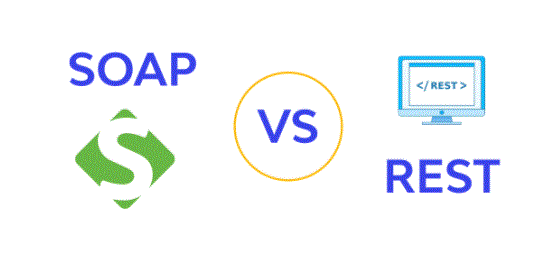
- Client-server architecture composed of clients, servers and resources.
- Stateless client-server communication, which means that no client content is stored on the server between requests. Instead information about the state of the session remains with the client.
- Cacheable data to eliminate the need for some client-server interaction.
- Uniform interface between components so that information can be transferred in a standardised form rather than specific to the needs of an application. It has been described by Roy Fielding, the originator of REST, as “the central feature that differentiates the REST architectural style from other network-based styles.”
- A layered system constraint, where client-server interactions can be mediated by hierarchical layers.
- Code on Demand allows the server to extend the functionality of the client by moving the executable code (though reducing visibility, making this an optional guideline).
- REST was specifically designed to work with components such as media components, files or even objects on a particular hardware device. Any web service which is defined on the principles of REST can be called as RESTful web service. A rest service will use the common HTTP verbs of GET, POST, PUT and DELETE to work with the required components. REST stands for Representational State Transfer.
What is REST?
REST is a set of architectural principles tailored to the needs of lightweight web services and mobile applications. Since this is a set of guidelines, it leaves the implementation of these recommendations to the developers.
When a request for data is sent to a REST API, it is usually done via Hypertext Transfer Protocol (commonly referred to as HTTP). Once the request is received, APIs designed for REST (called RESTful APIs or RESTful web services) can return messages in a variety of formats: HTML, XML, plain text, and JSON. JSON (JavaScript Object Notation) is preferred as a messaging format because it can be read by any programming language (despite the name), is human- and machine-readable, and is lightweight. In this way, RESTful APIs are more flexible and can be easier to set up.
An application is said to be RESTful if it follows the 6 Vastu guidelines. A reliable application should have:
- SOAP: SOAP is a protocol based totally on XML and operates over diverse decrease-stage protocols, which include HTTP, SMTP, TCP, and so on. It is predicated on XML for message layout and is designed to be platform-impartial and language-neutral.
- REST: REST is an architectural fashion, not a protocol, and it operates over the HTTP protocol. It leverages the usual HTTP techniques (GET, POST, PUT, DELETE) for performing operations on sources.
- SOAP: SOAP messages are generally XML-primarily based and are quite more complicated because of the XML shape. They include both the message records and the protocol information (headers) inside the XML.
- REST: REST messages are typically represented in simple text, JSON, or XML layout, making them extra lightweight in comparison to SOAP. RESTful APIs are generally less difficult to read and apprehend.
- SOAP: SOAP enables stateful operations, because of this that each request from a patron to the server ought to encompass all of the facts required to interpret and procedure the request.
- REST: REST is stateless, which means every request from a customer to the server should contain all the information to recognize and system the request. The server-side state isn’t preserved between requests.
- REST: REST relies on the safety mechanisms furnished by way of the underlying shipping protocol (HTTP), which includes SSL/TLS for encryption and HTTPS for steady conversation.
- SOAP: SOAP messages can be extra great because of the XML format, main to extra overhead in phrases of message length and processing time.
- REST:REST messages are normally smaller, extra lightweight, and require much less processing overhead, resulting in higher performance.
- SOAP: SOAP has been extensively utilized in agency-degree programs, mainly in scenarios in which strict safety and reliability are critical, along with in net services for monetary transactions or healthcare.
- REST:REST has gained a full-size reputation, specifically with the rise of cellular and internet applications, due to its simplicity, lightweight nature, and compatibility with current internet technologies.
Key Differences: for SOAP and REST
Protocol Type:
Message Format:
Statefulness:
Flexibility:
Performance:
Industry Adoption:
- Web and Mobile Applications: REST is an excellent choice for building APIs that power web and mobile applications. Its lightweight nature makes it well-suited for handling requests and responses in a distributed environment.
- Public APIs: REST is commonly used for building public APIs because it allows developers to interact with the API using standard HTTP methods and data formats like JSON. This simplicity makes it easier for third-party developers to understand and integrate with the API.
- Microservices Architecture: RESTful APIs are often used in microservices architectures, where each A microservice is in charge of a single task and communicates with other services. over HTTP using RESTful principles.
- Cloud-Based Applications: RESTful APIs are ideal for applications deployed in cloud environments because they can be accessed over standard HTTP/HTTPS, which is typically allowed in most cloud infrastructure setups.
- Internet of Things (IoT): RESTful APIs can be used to expose and manage resources in IoT devices. The lightweight nature of REST makes it suitable for resource-constrained devices.
- Integration between Web Services: When integrating different web services or systems, REST is a good choice because it relies on standard HTTP methods, which are widely supported.
- Statelessness Requirement: If statelessness is a critical requirement, REST is preferred. Stateless communication simplifies the scaling and load balancing of servers.
- High Performance: For applications that require high performance and low overhead, REST is often a better choice compared to more complex protocols like SOAP.
- Cacheability: REST allows caching of responses, which can significantly improve the performance and reduce the load on the server.
- Compatibility with Web Standards: RESTful APIs are closely aligned with the principles of the World Wide Web and HTTP, making them compatible with existing web infrastructure and web development tools.
When should REST be used?
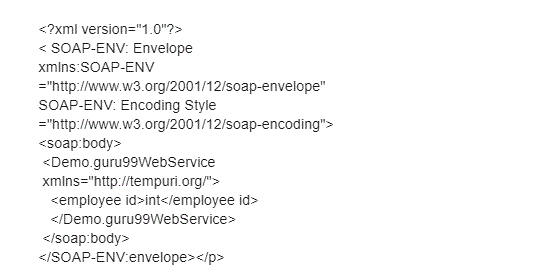
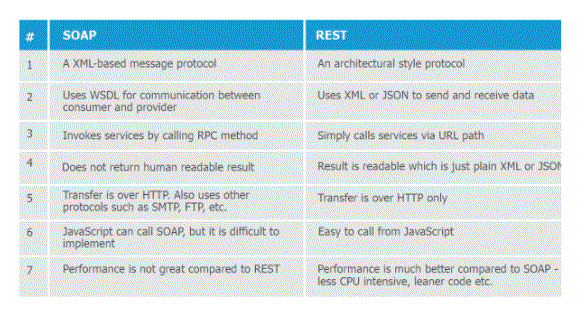
When should SOAP be used?
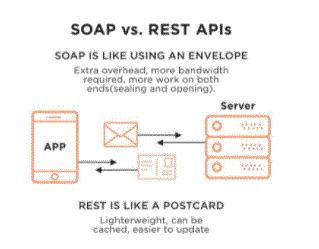
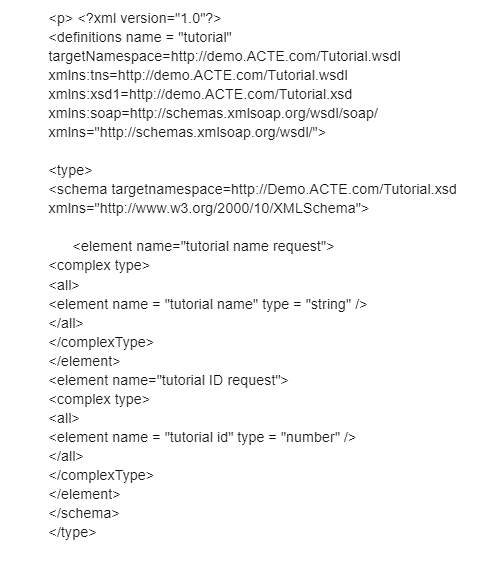
- Language, platform and transport independent (REST requires the use of HTTP)
- Works well in distributed enterprise environments (REST assumes direct point-to-point communication)
- Standardised
- Provides significant pre-build extensibility in the form of WS* standards
- Built-in error handling
- Automation when used with certain language products
- No expensive tools are required to interact with the web service
- Short learning curve
- Efficient (SOAP uses XML for all messages, REST can use shorter message formats)
- Fast (does not require extensive processing)
- Closer to other web technologies in design philosophy
Advantage of SOAP and Rest:
Benefits of SOAP
SOAP provides the following advantages over REST:
Rest profit
For the most part REST is easier to use and more flexible. It has the following advantages over SOAP:
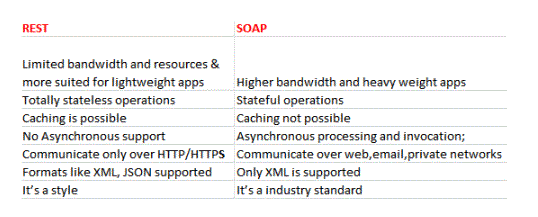
- SOAP is a completely XML-based protocol, the data formatting is in XML so it is easy for the programmer to understand.
- It is a platform independent protocol.
- It is an open standard protocol so anyone can use it.
- It is an extension of the HTTP protocol for XML messaging.
- SOAP messaging is useful for transmitting messages from one computer to another.
- It is also possible to implement a client-server architecture. The client can invoke a remote procedure call located on the server-side using SOAP protocol messaging.
- SOAP provides data transport for web services.
- SOAP works by sending an envelope that contains information about what needs to be done with web services. A typical SOAP envelope consists of a WSDL (Web Service Definition Language) file along with a header and body. This entire envelope is sent to the service provider and hence SOAP requires large bandwidth.
- These are fast web services as they consume less bandwidth and resources.
- REST can be written in any programming language.
- These services can be executed on any platform.
- It is a lightweight and scalable service built on the REST architecture.
- It uses HTTP verbs like GET, POST, DELETE, PUT and PATCH for CRUD (Create, Read, Update and Delete) operations.
- It supports basic communication encryption via TLS (Transport Layer Security), so is less secure than SOAP.
- It is easy to develop.
- It requires less bandwidth than SOAP.
Features of SOAP and Rest:
Features of Rest:
Conclusion:
We discussed the two most popular web services SOAP and REST. Both have their own importance in different scenarios. We have to choose any one of them based on our requirements and the complexity of the application. REST is easy to develop but on the other hand SOAP provides many other options so it is a bit difficult to develop




